Report on Hope's Efficiency in Material Manufacturing Safety in UK
VerifiedAdded on 2022/09/08
|15
|4078
|18
Report
AI Summary
This report delves into the critical role of safety management, specifically focusing on the 'Hope' framework within the UK's material manufacturing industry. It begins by highlighting the prevalence of accidents and the need for robust safety measures, emphasizing the importance of corporate governance codes. The report explores the four key elements of Hope: Safety Policy, Risk Management, Safety Assurance, and Safety Promotion, detailing their functions and contributions to a safer work environment. It examines various hazards in the material manufacturing industry, including chemical, physical, biological, and ergonomic hazards, and discusses their potential consequences. The report also analyzes the problems related to the efficiency of Hope, offering insights into how the system can be improved. The research is based on secondary research, providing a comprehensive overview of safety management regulations and their impact on the industry.
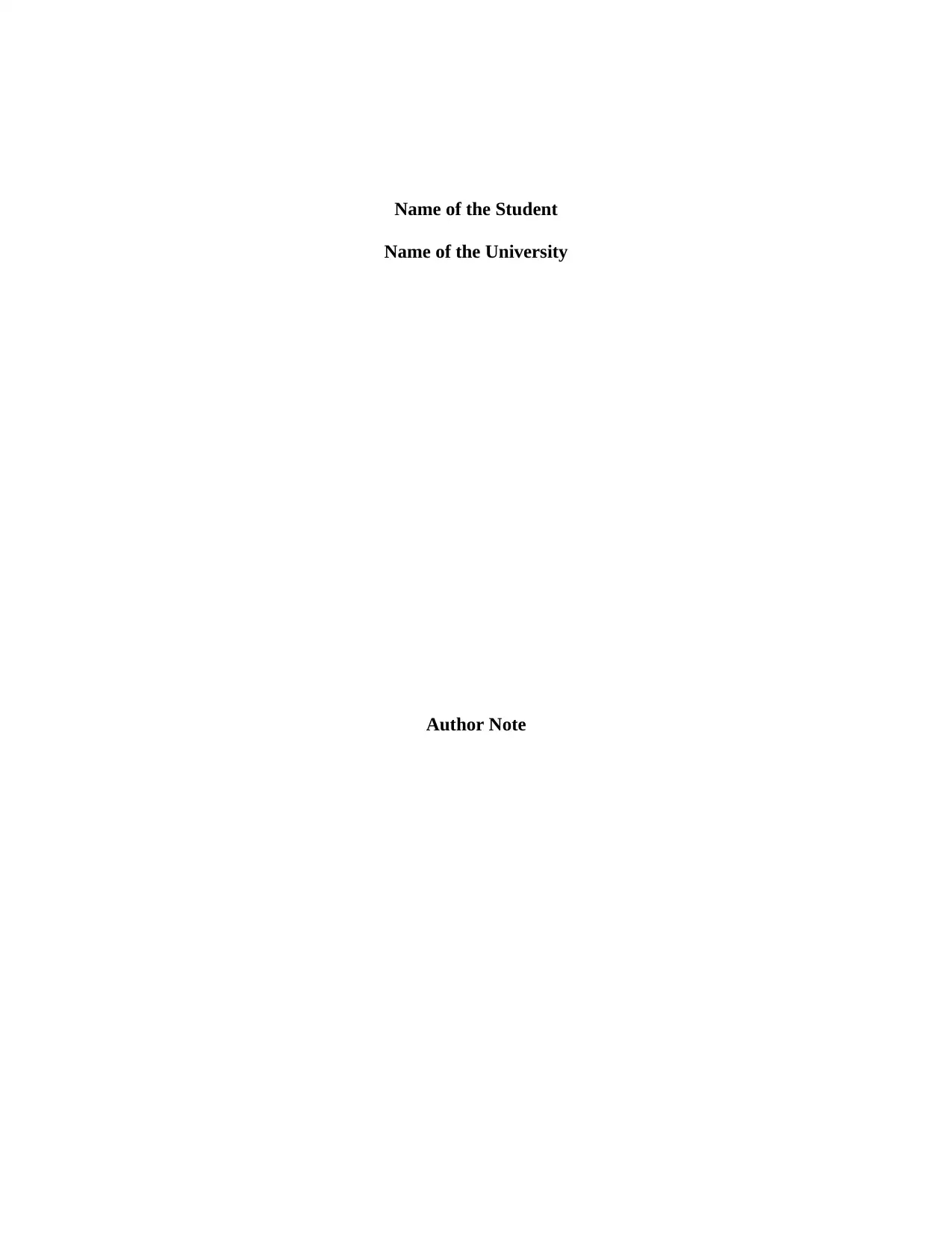
Name of the Student
Name of the University
Author Note
Name of the University
Author Note
Paraphrase This Document
Need a fresh take? Get an instant paraphrase of this document with our AI Paraphraser
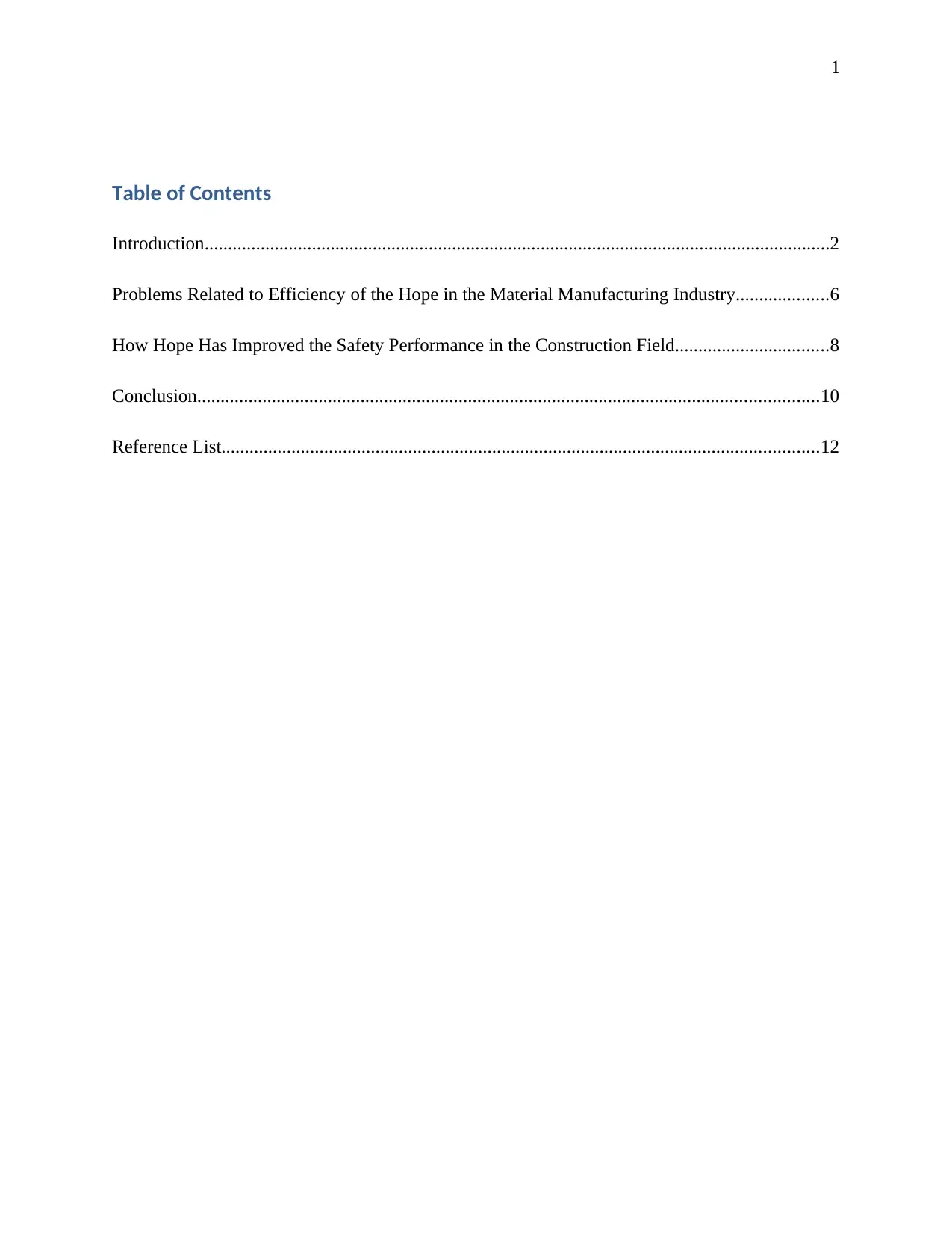
1
Table of Contents
Introduction......................................................................................................................................2
Problems Related to Efficiency of the Hope in the Material Manufacturing Industry....................6
How Hope Has Improved the Safety Performance in the Construction Field.................................8
Conclusion.....................................................................................................................................10
Reference List................................................................................................................................12
Table of Contents
Introduction......................................................................................................................................2
Problems Related to Efficiency of the Hope in the Material Manufacturing Industry....................6
How Hope Has Improved the Safety Performance in the Construction Field.................................8
Conclusion.....................................................................................................................................10
Reference List................................................................................................................................12
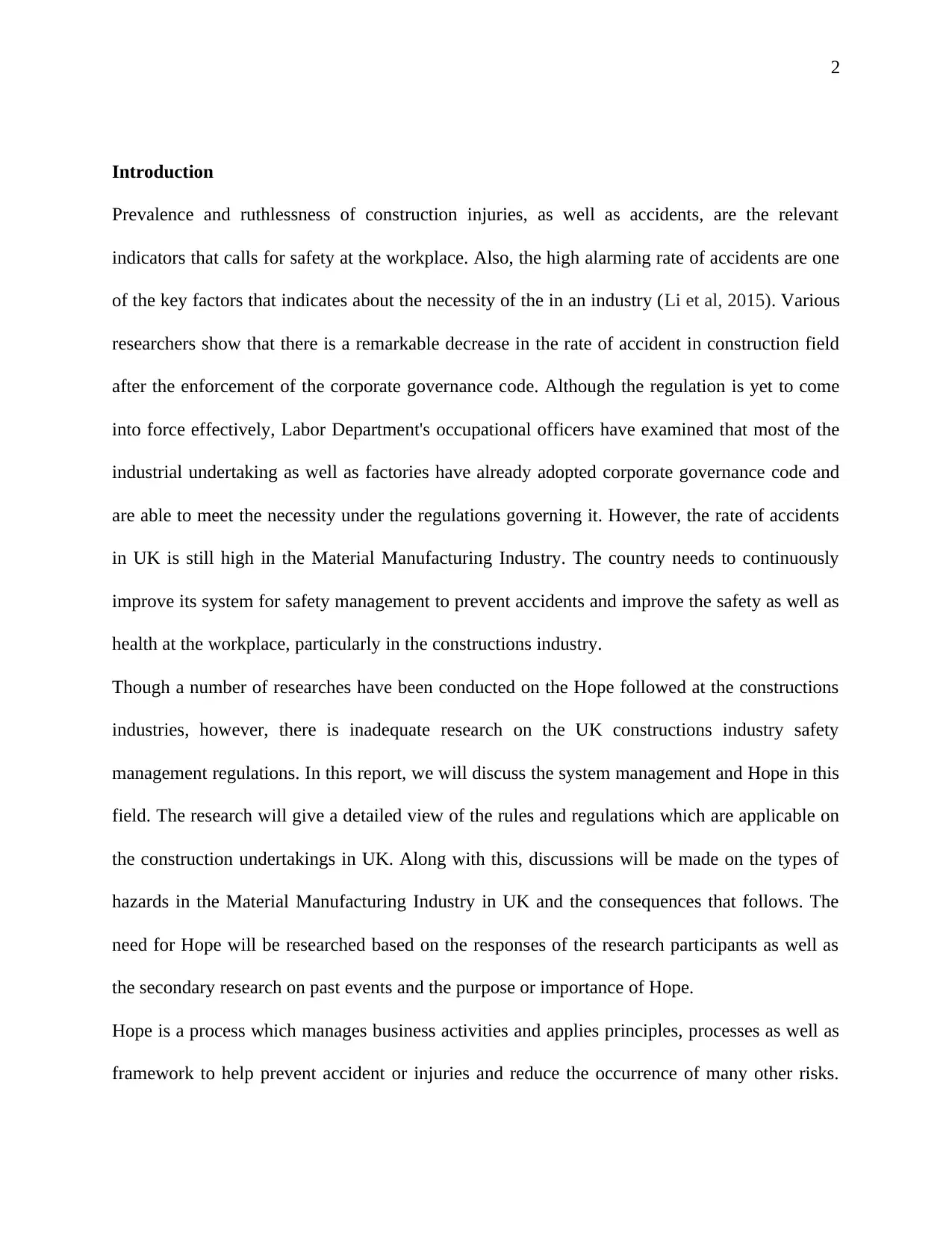
2
Introduction
Prevalence and ruthlessness of construction injuries, as well as accidents, are the relevant
indicators that calls for safety at the workplace. Also, the high alarming rate of accidents are one
of the key factors that indicates about the necessity of the in an industry (Li et al, 2015). Various
researchers show that there is a remarkable decrease in the rate of accident in construction field
after the enforcement of the corporate governance code. Although the regulation is yet to come
into force effectively, Labor Department's occupational officers have examined that most of the
industrial undertaking as well as factories have already adopted corporate governance code and
are able to meet the necessity under the regulations governing it. However, the rate of accidents
in UK is still high in the Material Manufacturing Industry. The country needs to continuously
improve its system for safety management to prevent accidents and improve the safety as well as
health at the workplace, particularly in the constructions industry.
Though a number of researches have been conducted on the Hope followed at the constructions
industries, however, there is inadequate research on the UK constructions industry safety
management regulations. In this report, we will discuss the system management and Hope in this
field. The research will give a detailed view of the rules and regulations which are applicable on
the construction undertakings in UK. Along with this, discussions will be made on the types of
hazards in the Material Manufacturing Industry in UK and the consequences that follows. The
need for Hope will be researched based on the responses of the research participants as well as
the secondary research on past events and the purpose or importance of Hope.
Hope is a process which manages business activities and applies principles, processes as well as
framework to help prevent accident or injuries and reduce the occurrence of many other risks.
Introduction
Prevalence and ruthlessness of construction injuries, as well as accidents, are the relevant
indicators that calls for safety at the workplace. Also, the high alarming rate of accidents are one
of the key factors that indicates about the necessity of the in an industry (Li et al, 2015). Various
researchers show that there is a remarkable decrease in the rate of accident in construction field
after the enforcement of the corporate governance code. Although the regulation is yet to come
into force effectively, Labor Department's occupational officers have examined that most of the
industrial undertaking as well as factories have already adopted corporate governance code and
are able to meet the necessity under the regulations governing it. However, the rate of accidents
in UK is still high in the Material Manufacturing Industry. The country needs to continuously
improve its system for safety management to prevent accidents and improve the safety as well as
health at the workplace, particularly in the constructions industry.
Though a number of researches have been conducted on the Hope followed at the constructions
industries, however, there is inadequate research on the UK constructions industry safety
management regulations. In this report, we will discuss the system management and Hope in this
field. The research will give a detailed view of the rules and regulations which are applicable on
the construction undertakings in UK. Along with this, discussions will be made on the types of
hazards in the Material Manufacturing Industry in UK and the consequences that follows. The
need for Hope will be researched based on the responses of the research participants as well as
the secondary research on past events and the purpose or importance of Hope.
Hope is a process which manages business activities and applies principles, processes as well as
framework to help prevent accident or injuries and reduce the occurrence of many other risks.
⊘ This is a preview!⊘
Do you want full access?
Subscribe today to unlock all pages.

Trusted by 1+ million students worldwide
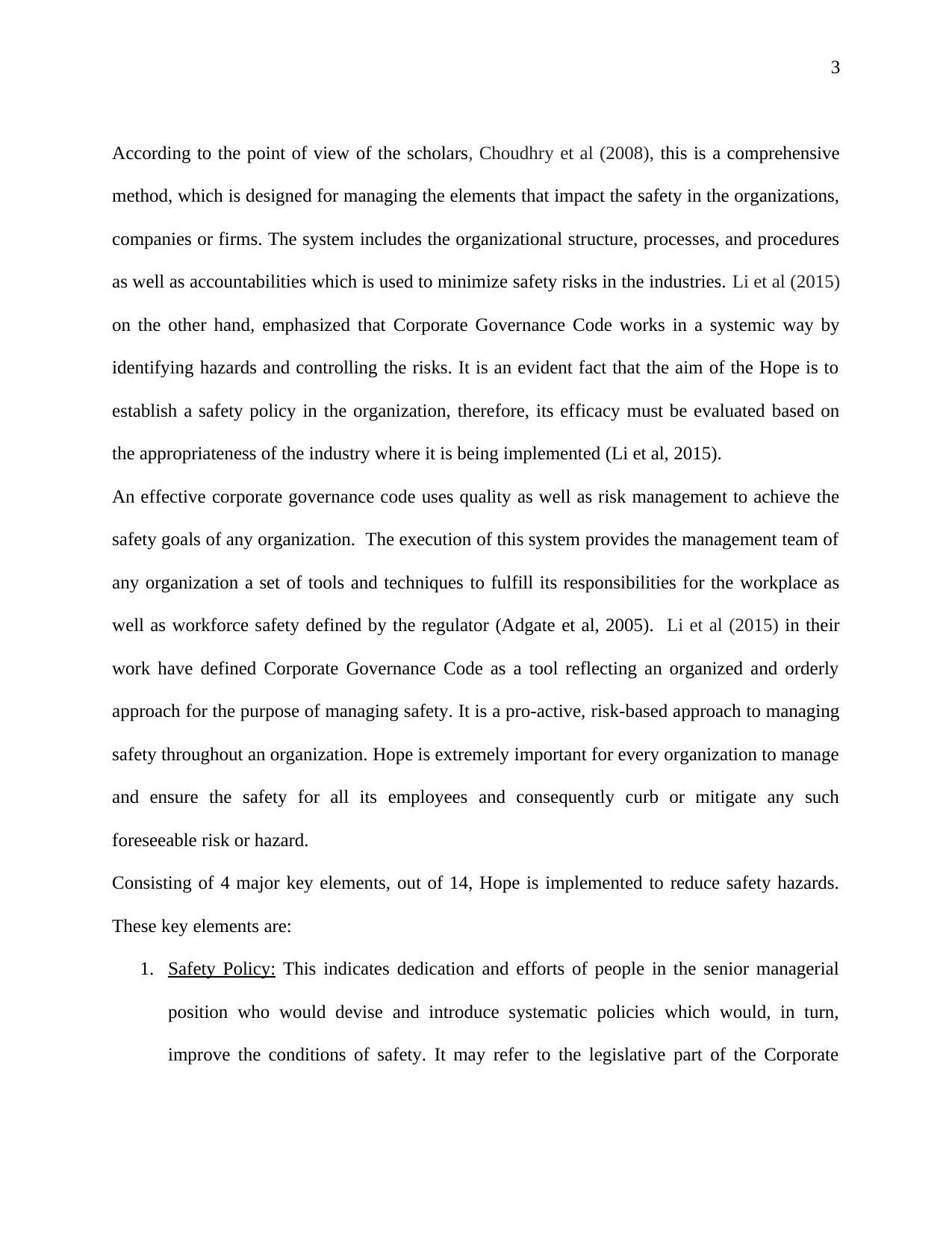
3
According to the point of view of the scholars, Choudhry et al (2008), this is a comprehensive
method, which is designed for managing the elements that impact the safety in the organizations,
companies or firms. The system includes the organizational structure, processes, and procedures
as well as accountabilities which is used to minimize safety risks in the industries. Li et al (2015)
on the other hand, emphasized that Corporate Governance Code works in a systemic way by
identifying hazards and controlling the risks. It is an evident fact that the aim of the Hope is to
establish a safety policy in the organization, therefore, its efficacy must be evaluated based on
the appropriateness of the industry where it is being implemented (Li et al, 2015).
An effective corporate governance code uses quality as well as risk management to achieve the
safety goals of any organization. The execution of this system provides the management team of
any organization a set of tools and techniques to fulfill its responsibilities for the workplace as
well as workforce safety defined by the regulator (Adgate et al, 2005). Li et al (2015) in their
work have defined Corporate Governance Code as a tool reflecting an organized and orderly
approach for the purpose of managing safety. It is a pro-active, risk-based approach to managing
safety throughout an organization. Hope is extremely important for every organization to manage
and ensure the safety for all its employees and consequently curb or mitigate any such
foreseeable risk or hazard.
Consisting of 4 major key elements, out of 14, Hope is implemented to reduce safety hazards.
These key elements are:
1. Safety Policy: This indicates dedication and efforts of people in the senior managerial
position who would devise and introduce systematic policies which would, in turn,
improve the conditions of safety. It may refer to the legislative part of the Corporate
According to the point of view of the scholars, Choudhry et al (2008), this is a comprehensive
method, which is designed for managing the elements that impact the safety in the organizations,
companies or firms. The system includes the organizational structure, processes, and procedures
as well as accountabilities which is used to minimize safety risks in the industries. Li et al (2015)
on the other hand, emphasized that Corporate Governance Code works in a systemic way by
identifying hazards and controlling the risks. It is an evident fact that the aim of the Hope is to
establish a safety policy in the organization, therefore, its efficacy must be evaluated based on
the appropriateness of the industry where it is being implemented (Li et al, 2015).
An effective corporate governance code uses quality as well as risk management to achieve the
safety goals of any organization. The execution of this system provides the management team of
any organization a set of tools and techniques to fulfill its responsibilities for the workplace as
well as workforce safety defined by the regulator (Adgate et al, 2005). Li et al (2015) in their
work have defined Corporate Governance Code as a tool reflecting an organized and orderly
approach for the purpose of managing safety. It is a pro-active, risk-based approach to managing
safety throughout an organization. Hope is extremely important for every organization to manage
and ensure the safety for all its employees and consequently curb or mitigate any such
foreseeable risk or hazard.
Consisting of 4 major key elements, out of 14, Hope is implemented to reduce safety hazards.
These key elements are:
1. Safety Policy: This indicates dedication and efforts of people in the senior managerial
position who would devise and introduce systematic policies which would, in turn,
improve the conditions of safety. It may refer to the legislative part of the Corporate
Paraphrase This Document
Need a fresh take? Get an instant paraphrase of this document with our AI Paraphraser
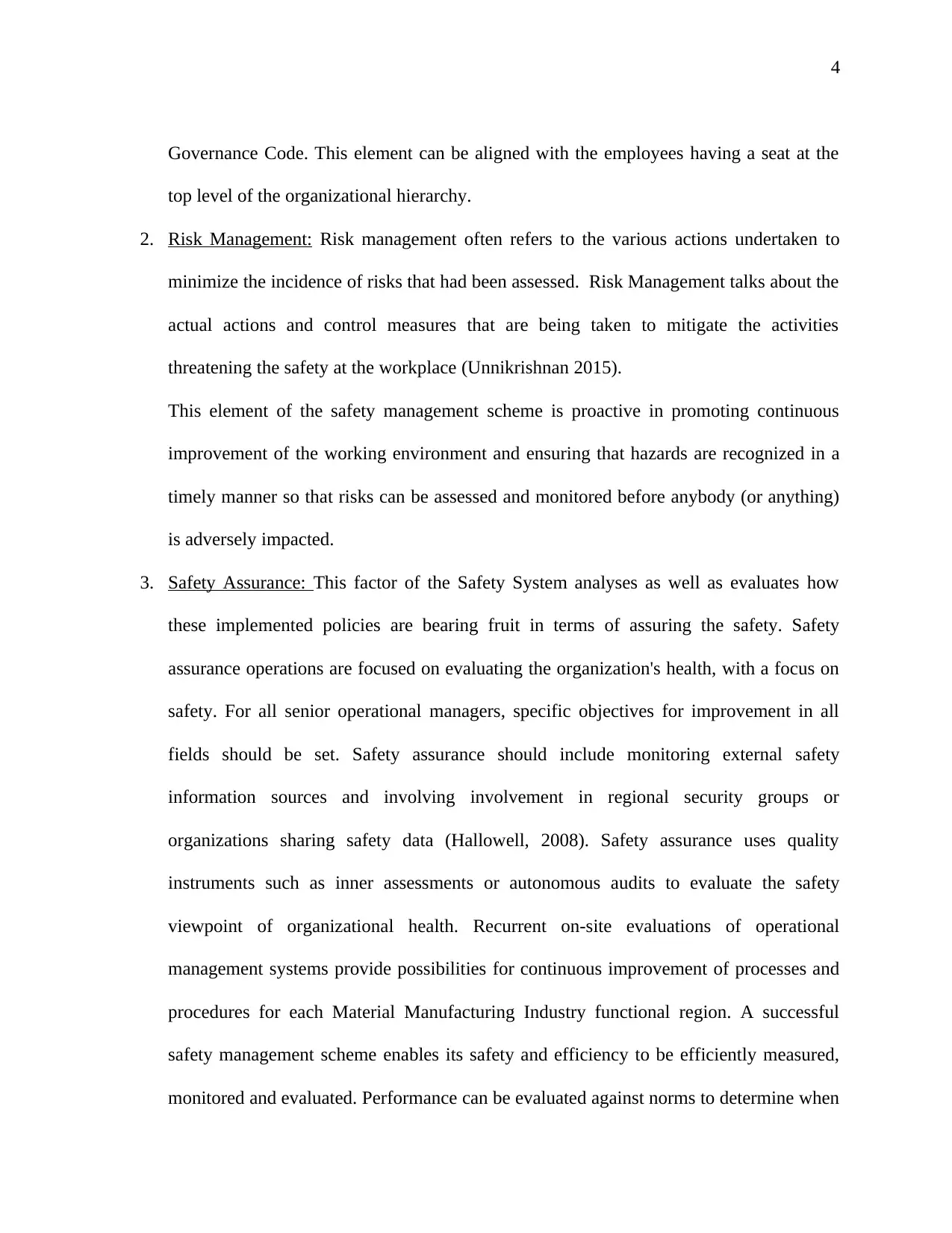
4
Governance Code. This element can be aligned with the employees having a seat at the
top level of the organizational hierarchy.
2. Risk Management: Risk management often refers to the various actions undertaken to
minimize the incidence of risks that had been assessed. Risk Management talks about the
actual actions and control measures that are being taken to mitigate the activities
threatening the safety at the workplace (Unnikrishnan 2015).
This element of the safety management scheme is proactive in promoting continuous
improvement of the working environment and ensuring that hazards are recognized in a
timely manner so that risks can be assessed and monitored before anybody (or anything)
is adversely impacted.
3. Safety Assurance: This factor of the Safety System analyses as well as evaluates how
these implemented policies are bearing fruit in terms of assuring the safety. Safety
assurance operations are focused on evaluating the organization's health, with a focus on
safety. For all senior operational managers, specific objectives for improvement in all
fields should be set. Safety assurance should include monitoring external safety
information sources and involving involvement in regional security groups or
organizations sharing safety data (Hallowell, 2008). Safety assurance uses quality
instruments such as inner assessments or autonomous audits to evaluate the safety
viewpoint of organizational health. Recurrent on-site evaluations of operational
management systems provide possibilities for continuous improvement of processes and
procedures for each Material Manufacturing Industry functional region. A successful
safety management scheme enables its safety and efficiency to be efficiently measured,
monitored and evaluated. Performance can be evaluated against norms to determine when
Governance Code. This element can be aligned with the employees having a seat at the
top level of the organizational hierarchy.
2. Risk Management: Risk management often refers to the various actions undertaken to
minimize the incidence of risks that had been assessed. Risk Management talks about the
actual actions and control measures that are being taken to mitigate the activities
threatening the safety at the workplace (Unnikrishnan 2015).
This element of the safety management scheme is proactive in promoting continuous
improvement of the working environment and ensuring that hazards are recognized in a
timely manner so that risks can be assessed and monitored before anybody (or anything)
is adversely impacted.
3. Safety Assurance: This factor of the Safety System analyses as well as evaluates how
these implemented policies are bearing fruit in terms of assuring the safety. Safety
assurance operations are focused on evaluating the organization's health, with a focus on
safety. For all senior operational managers, specific objectives for improvement in all
fields should be set. Safety assurance should include monitoring external safety
information sources and involving involvement in regional security groups or
organizations sharing safety data (Hallowell, 2008). Safety assurance uses quality
instruments such as inner assessments or autonomous audits to evaluate the safety
viewpoint of organizational health. Recurrent on-site evaluations of operational
management systems provide possibilities for continuous improvement of processes and
procedures for each Material Manufacturing Industry functional region. A successful
safety management scheme enables its safety and efficiency to be efficiently measured,
monitored and evaluated. Performance can be evaluated against norms to determine when
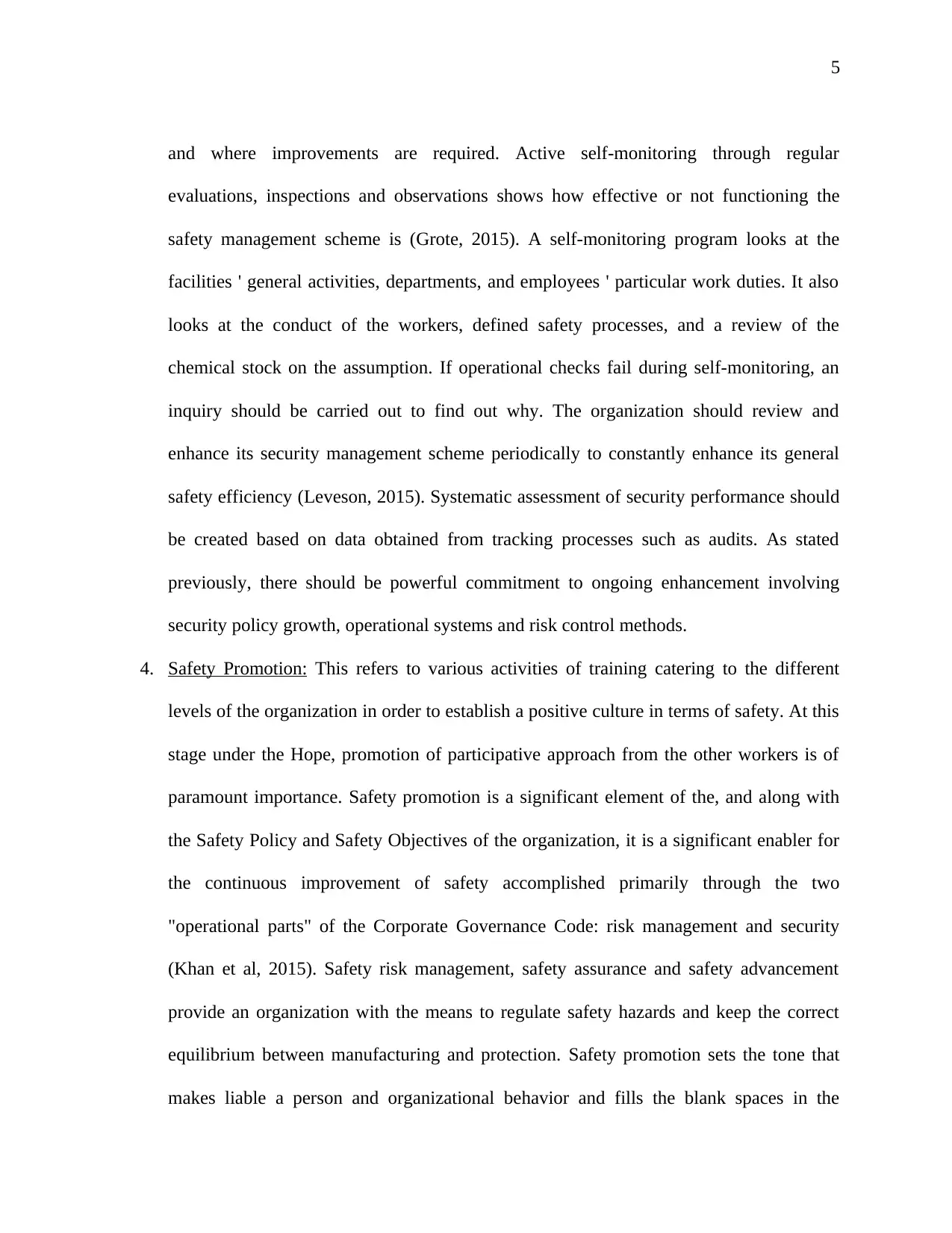
5
and where improvements are required. Active self-monitoring through regular
evaluations, inspections and observations shows how effective or not functioning the
safety management scheme is (Grote, 2015). A self-monitoring program looks at the
facilities ' general activities, departments, and employees ' particular work duties. It also
looks at the conduct of the workers, defined safety processes, and a review of the
chemical stock on the assumption. If operational checks fail during self-monitoring, an
inquiry should be carried out to find out why. The organization should review and
enhance its security management scheme periodically to constantly enhance its general
safety efficiency (Leveson, 2015). Systematic assessment of security performance should
be created based on data obtained from tracking processes such as audits. As stated
previously, there should be powerful commitment to ongoing enhancement involving
security policy growth, operational systems and risk control methods.
4. Safety Promotion: This refers to various activities of training catering to the different
levels of the organization in order to establish a positive culture in terms of safety. At this
stage under the Hope, promotion of participative approach from the other workers is of
paramount importance. Safety promotion is a significant element of the, and along with
the Safety Policy and Safety Objectives of the organization, it is a significant enabler for
the continuous improvement of safety accomplished primarily through the two
"operational parts" of the Corporate Governance Code: risk management and security
(Khan et al, 2015). Safety risk management, safety assurance and safety advancement
provide an organization with the means to regulate safety hazards and keep the correct
equilibrium between manufacturing and protection. Safety promotion sets the tone that
makes liable a person and organizational behavior and fills the blank spaces in the
and where improvements are required. Active self-monitoring through regular
evaluations, inspections and observations shows how effective or not functioning the
safety management scheme is (Grote, 2015). A self-monitoring program looks at the
facilities ' general activities, departments, and employees ' particular work duties. It also
looks at the conduct of the workers, defined safety processes, and a review of the
chemical stock on the assumption. If operational checks fail during self-monitoring, an
inquiry should be carried out to find out why. The organization should review and
enhance its security management scheme periodically to constantly enhance its general
safety efficiency (Leveson, 2015). Systematic assessment of security performance should
be created based on data obtained from tracking processes such as audits. As stated
previously, there should be powerful commitment to ongoing enhancement involving
security policy growth, operational systems and risk control methods.
4. Safety Promotion: This refers to various activities of training catering to the different
levels of the organization in order to establish a positive culture in terms of safety. At this
stage under the Hope, promotion of participative approach from the other workers is of
paramount importance. Safety promotion is a significant element of the, and along with
the Safety Policy and Safety Objectives of the organization, it is a significant enabler for
the continuous improvement of safety accomplished primarily through the two
"operational parts" of the Corporate Governance Code: risk management and security
(Khan et al, 2015). Safety risk management, safety assurance and safety advancement
provide an organization with the means to regulate safety hazards and keep the correct
equilibrium between manufacturing and protection. Safety promotion sets the tone that
makes liable a person and organizational behavior and fills the blank spaces in the
⊘ This is a preview!⊘
Do you want full access?
Subscribe today to unlock all pages.

Trusted by 1+ million students worldwide
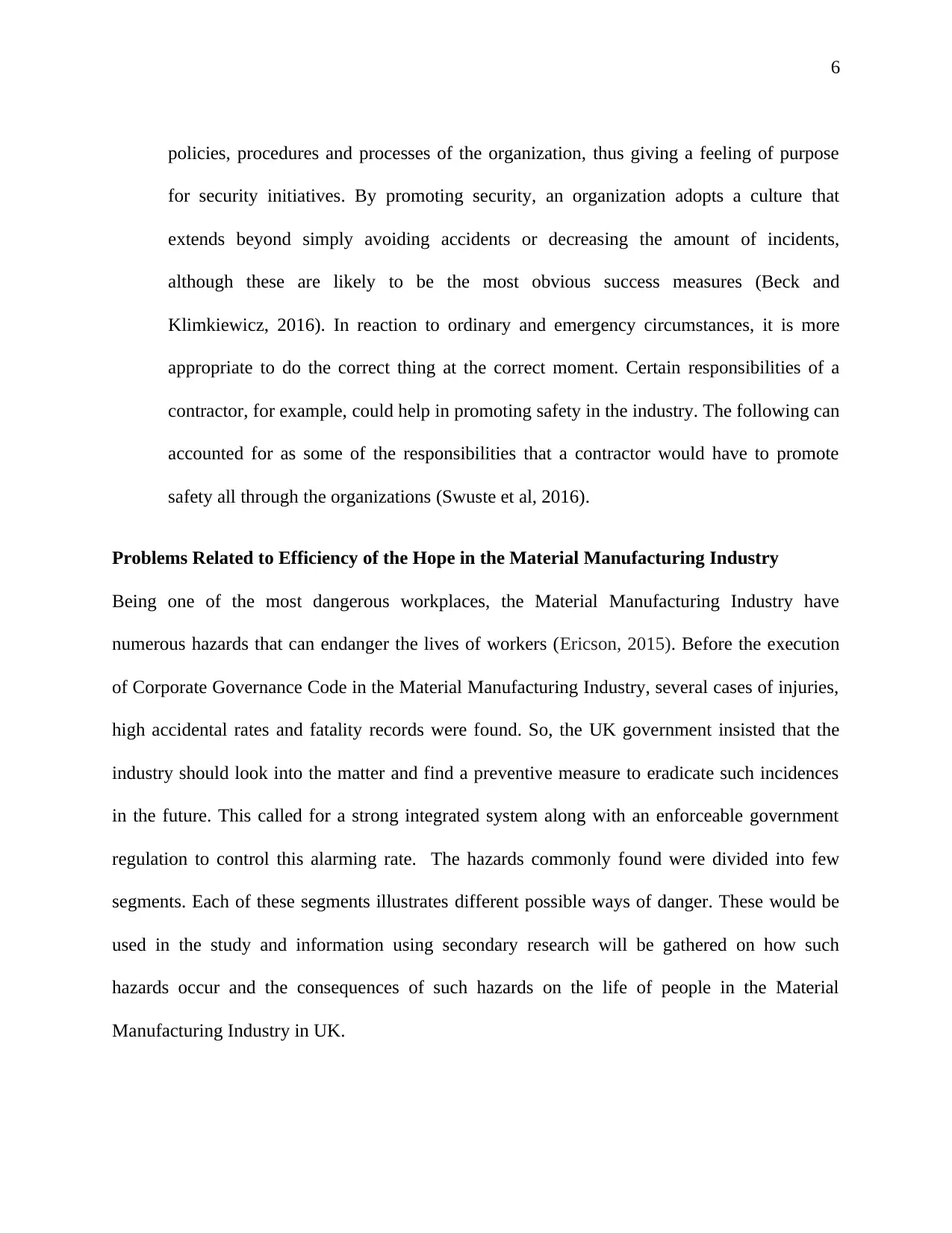
6
policies, procedures and processes of the organization, thus giving a feeling of purpose
for security initiatives. By promoting security, an organization adopts a culture that
extends beyond simply avoiding accidents or decreasing the amount of incidents,
although these are likely to be the most obvious success measures (Beck and
Klimkiewicz, 2016). In reaction to ordinary and emergency circumstances, it is more
appropriate to do the correct thing at the correct moment. Certain responsibilities of a
contractor, for example, could help in promoting safety in the industry. The following can
accounted for as some of the responsibilities that a contractor would have to promote
safety all through the organizations (Swuste et al, 2016).
Problems Related to Efficiency of the Hope in the Material Manufacturing Industry
Being one of the most dangerous workplaces, the Material Manufacturing Industry have
numerous hazards that can endanger the lives of workers (Ericson, 2015). Before the execution
of Corporate Governance Code in the Material Manufacturing Industry, several cases of injuries,
high accidental rates and fatality records were found. So, the UK government insisted that the
industry should look into the matter and find a preventive measure to eradicate such incidences
in the future. This called for a strong integrated system along with an enforceable government
regulation to control this alarming rate. The hazards commonly found were divided into few
segments. Each of these segments illustrates different possible ways of danger. These would be
used in the study and information using secondary research will be gathered on how such
hazards occur and the consequences of such hazards on the life of people in the Material
Manufacturing Industry in UK.
policies, procedures and processes of the organization, thus giving a feeling of purpose
for security initiatives. By promoting security, an organization adopts a culture that
extends beyond simply avoiding accidents or decreasing the amount of incidents,
although these are likely to be the most obvious success measures (Beck and
Klimkiewicz, 2016). In reaction to ordinary and emergency circumstances, it is more
appropriate to do the correct thing at the correct moment. Certain responsibilities of a
contractor, for example, could help in promoting safety in the industry. The following can
accounted for as some of the responsibilities that a contractor would have to promote
safety all through the organizations (Swuste et al, 2016).
Problems Related to Efficiency of the Hope in the Material Manufacturing Industry
Being one of the most dangerous workplaces, the Material Manufacturing Industry have
numerous hazards that can endanger the lives of workers (Ericson, 2015). Before the execution
of Corporate Governance Code in the Material Manufacturing Industry, several cases of injuries,
high accidental rates and fatality records were found. So, the UK government insisted that the
industry should look into the matter and find a preventive measure to eradicate such incidences
in the future. This called for a strong integrated system along with an enforceable government
regulation to control this alarming rate. The hazards commonly found were divided into few
segments. Each of these segments illustrates different possible ways of danger. These would be
used in the study and information using secondary research will be gathered on how such
hazards occur and the consequences of such hazards on the life of people in the Material
Manufacturing Industry in UK.
Paraphrase This Document
Need a fresh take? Get an instant paraphrase of this document with our AI Paraphraser
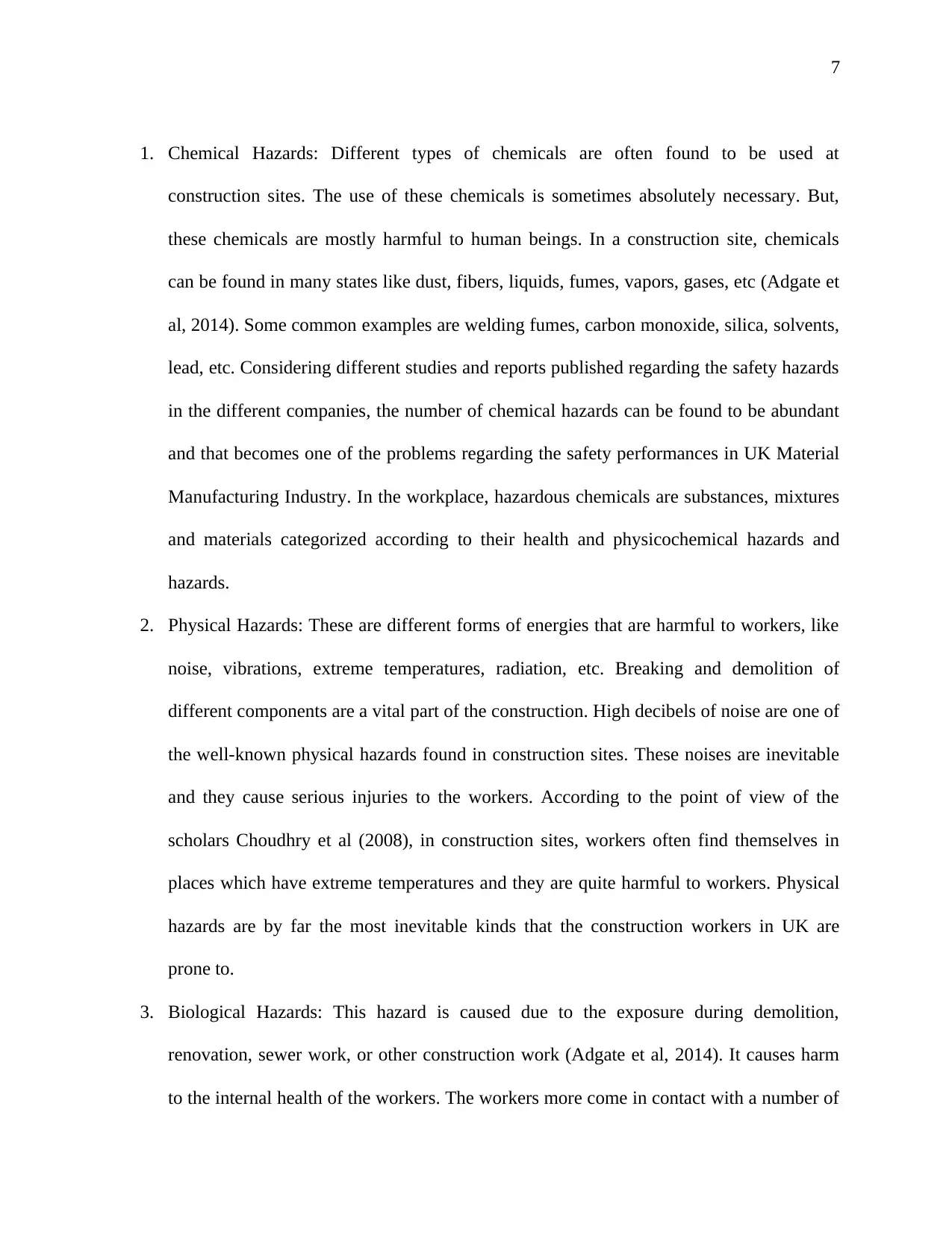
7
1. Chemical Hazards: Different types of chemicals are often found to be used at
construction sites. The use of these chemicals is sometimes absolutely necessary. But,
these chemicals are mostly harmful to human beings. In a construction site, chemicals
can be found in many states like dust, fibers, liquids, fumes, vapors, gases, etc (Adgate et
al, 2014). Some common examples are welding fumes, carbon monoxide, silica, solvents,
lead, etc. Considering different studies and reports published regarding the safety hazards
in the different companies, the number of chemical hazards can be found to be abundant
and that becomes one of the problems regarding the safety performances in UK Material
Manufacturing Industry. In the workplace, hazardous chemicals are substances, mixtures
and materials categorized according to their health and physicochemical hazards and
hazards.
2. Physical Hazards: These are different forms of energies that are harmful to workers, like
noise, vibrations, extreme temperatures, radiation, etc. Breaking and demolition of
different components are a vital part of the construction. High decibels of noise are one of
the well-known physical hazards found in construction sites. These noises are inevitable
and they cause serious injuries to the workers. According to the point of view of the
scholars Choudhry et al (2008), in construction sites, workers often find themselves in
places which have extreme temperatures and they are quite harmful to workers. Physical
hazards are by far the most inevitable kinds that the construction workers in UK are
prone to.
3. Biological Hazards: This hazard is caused due to the exposure during demolition,
renovation, sewer work, or other construction work (Adgate et al, 2014). It causes harm
to the internal health of the workers. The workers more come in contact with a number of
1. Chemical Hazards: Different types of chemicals are often found to be used at
construction sites. The use of these chemicals is sometimes absolutely necessary. But,
these chemicals are mostly harmful to human beings. In a construction site, chemicals
can be found in many states like dust, fibers, liquids, fumes, vapors, gases, etc (Adgate et
al, 2014). Some common examples are welding fumes, carbon monoxide, silica, solvents,
lead, etc. Considering different studies and reports published regarding the safety hazards
in the different companies, the number of chemical hazards can be found to be abundant
and that becomes one of the problems regarding the safety performances in UK Material
Manufacturing Industry. In the workplace, hazardous chemicals are substances, mixtures
and materials categorized according to their health and physicochemical hazards and
hazards.
2. Physical Hazards: These are different forms of energies that are harmful to workers, like
noise, vibrations, extreme temperatures, radiation, etc. Breaking and demolition of
different components are a vital part of the construction. High decibels of noise are one of
the well-known physical hazards found in construction sites. These noises are inevitable
and they cause serious injuries to the workers. According to the point of view of the
scholars Choudhry et al (2008), in construction sites, workers often find themselves in
places which have extreme temperatures and they are quite harmful to workers. Physical
hazards are by far the most inevitable kinds that the construction workers in UK are
prone to.
3. Biological Hazards: This hazard is caused due to the exposure during demolition,
renovation, sewer work, or other construction work (Adgate et al, 2014). It causes harm
to the internal health of the workers. The workers more come in contact with a number of
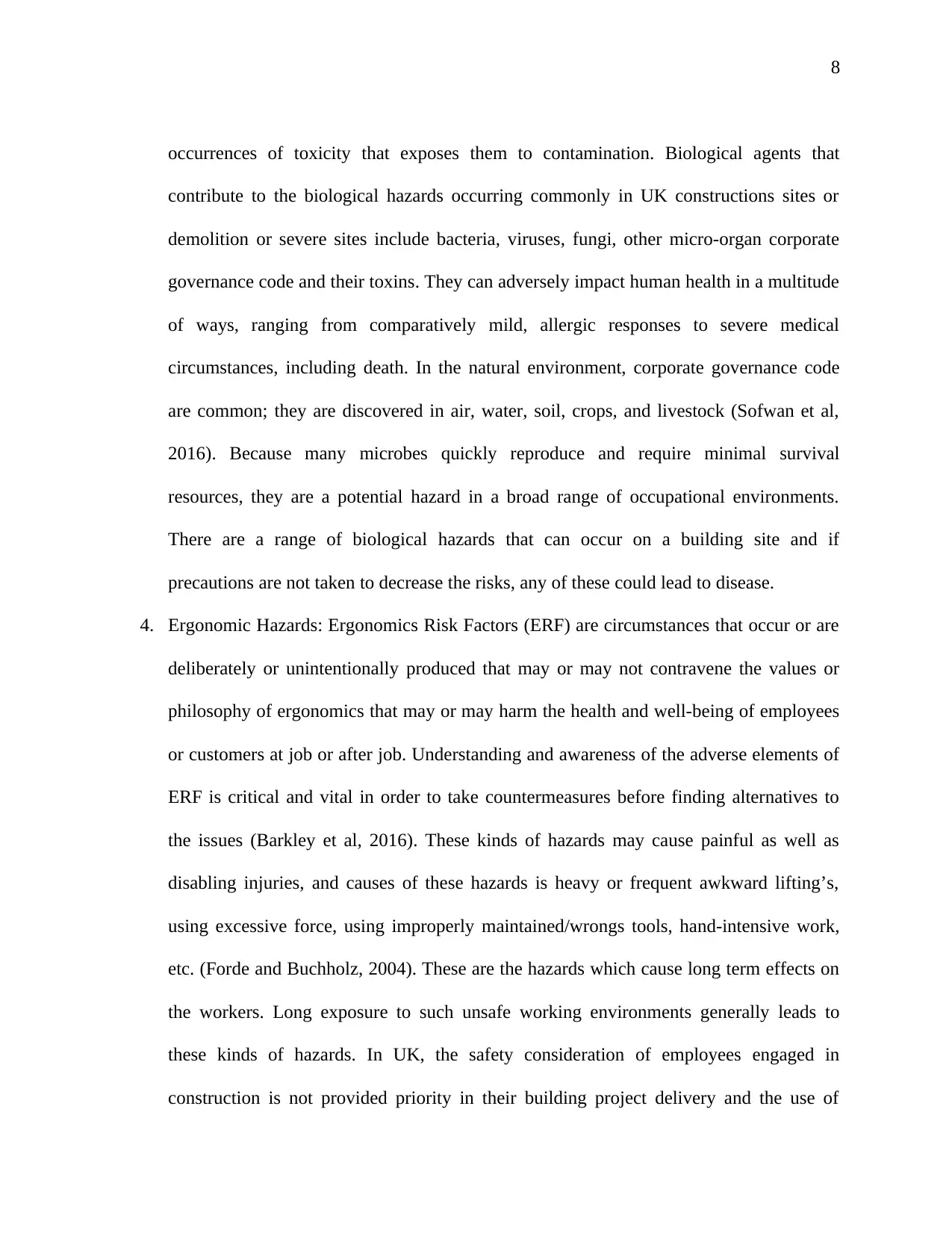
8
occurrences of toxicity that exposes them to contamination. Biological agents that
contribute to the biological hazards occurring commonly in UK constructions sites or
demolition or severe sites include bacteria, viruses, fungi, other micro-organ corporate
governance code and their toxins. They can adversely impact human health in a multitude
of ways, ranging from comparatively mild, allergic responses to severe medical
circumstances, including death. In the natural environment, corporate governance code
are common; they are discovered in air, water, soil, crops, and livestock (Sofwan et al,
2016). Because many microbes quickly reproduce and require minimal survival
resources, they are a potential hazard in a broad range of occupational environments.
There are a range of biological hazards that can occur on a building site and if
precautions are not taken to decrease the risks, any of these could lead to disease.
4. Ergonomic Hazards: Ergonomics Risk Factors (ERF) are circumstances that occur or are
deliberately or unintentionally produced that may or may not contravene the values or
philosophy of ergonomics that may or may harm the health and well-being of employees
or customers at job or after job. Understanding and awareness of the adverse elements of
ERF is critical and vital in order to take countermeasures before finding alternatives to
the issues (Barkley et al, 2016). These kinds of hazards may cause painful as well as
disabling injuries, and causes of these hazards is heavy or frequent awkward lifting’s,
using excessive force, using improperly maintained/wrongs tools, hand-intensive work,
etc. (Forde and Buchholz, 2004). These are the hazards which cause long term effects on
the workers. Long exposure to such unsafe working environments generally leads to
these kinds of hazards. In UK, the safety consideration of employees engaged in
construction is not provided priority in their building project delivery and the use of
occurrences of toxicity that exposes them to contamination. Biological agents that
contribute to the biological hazards occurring commonly in UK constructions sites or
demolition or severe sites include bacteria, viruses, fungi, other micro-organ corporate
governance code and their toxins. They can adversely impact human health in a multitude
of ways, ranging from comparatively mild, allergic responses to severe medical
circumstances, including death. In the natural environment, corporate governance code
are common; they are discovered in air, water, soil, crops, and livestock (Sofwan et al,
2016). Because many microbes quickly reproduce and require minimal survival
resources, they are a potential hazard in a broad range of occupational environments.
There are a range of biological hazards that can occur on a building site and if
precautions are not taken to decrease the risks, any of these could lead to disease.
4. Ergonomic Hazards: Ergonomics Risk Factors (ERF) are circumstances that occur or are
deliberately or unintentionally produced that may or may not contravene the values or
philosophy of ergonomics that may or may harm the health and well-being of employees
or customers at job or after job. Understanding and awareness of the adverse elements of
ERF is critical and vital in order to take countermeasures before finding alternatives to
the issues (Barkley et al, 2016). These kinds of hazards may cause painful as well as
disabling injuries, and causes of these hazards is heavy or frequent awkward lifting’s,
using excessive force, using improperly maintained/wrongs tools, hand-intensive work,
etc. (Forde and Buchholz, 2004). These are the hazards which cause long term effects on
the workers. Long exposure to such unsafe working environments generally leads to
these kinds of hazards. In UK, the safety consideration of employees engaged in
construction is not provided priority in their building project delivery and the use of
⊘ This is a preview!⊘
Do you want full access?
Subscribe today to unlock all pages.

Trusted by 1+ million students worldwide
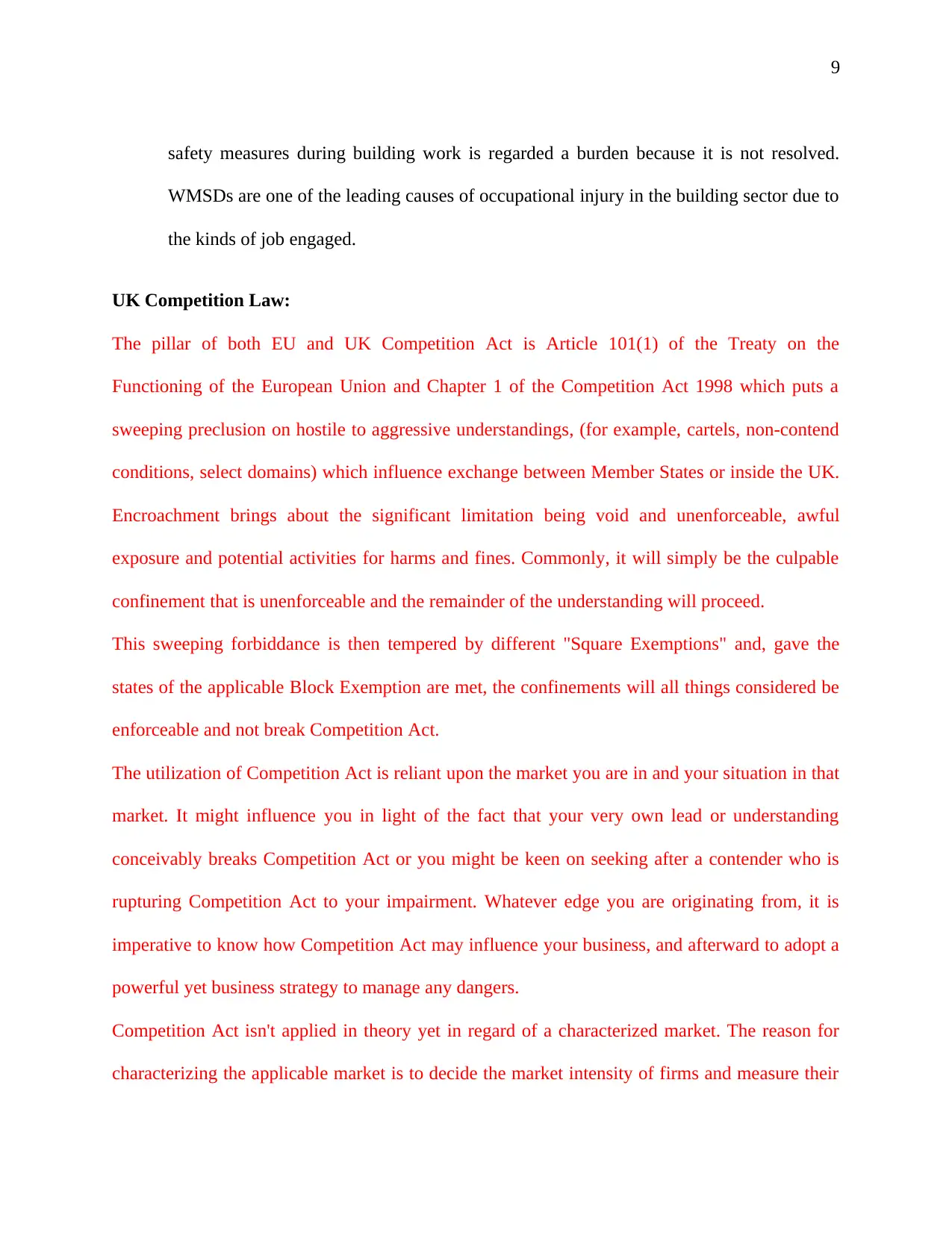
9
safety measures during building work is regarded a burden because it is not resolved.
WMSDs are one of the leading causes of occupational injury in the building sector due to
the kinds of job engaged.
UK Competition Law:
The pillar of both EU and UK Competition Act is Article 101(1) of the Treaty on the
Functioning of the European Union and Chapter 1 of the Competition Act 1998 which puts a
sweeping preclusion on hostile to aggressive understandings, (for example, cartels, non-contend
conditions, select domains) which influence exchange between Member States or inside the UK.
Encroachment brings about the significant limitation being void and unenforceable, awful
exposure and potential activities for harms and fines. Commonly, it will simply be the culpable
confinement that is unenforceable and the remainder of the understanding will proceed.
This sweeping forbiddance is then tempered by different "Square Exemptions" and, gave the
states of the applicable Block Exemption are met, the confinements will all things considered be
enforceable and not break Competition Act.
The utilization of Competition Act is reliant upon the market you are in and your situation in that
market. It might influence you in light of the fact that your very own lead or understanding
conceivably breaks Competition Act or you might be keen on seeking after a contender who is
rupturing Competition Act to your impairment. Whatever edge you are originating from, it is
imperative to know how Competition Act may influence your business, and afterward to adopt a
powerful yet business strategy to manage any dangers.
Competition Act isn't applied in theory yet in regard of a characterized market. The reason for
characterizing the applicable market is to decide the market intensity of firms and measure their
safety measures during building work is regarded a burden because it is not resolved.
WMSDs are one of the leading causes of occupational injury in the building sector due to
the kinds of job engaged.
UK Competition Law:
The pillar of both EU and UK Competition Act is Article 101(1) of the Treaty on the
Functioning of the European Union and Chapter 1 of the Competition Act 1998 which puts a
sweeping preclusion on hostile to aggressive understandings, (for example, cartels, non-contend
conditions, select domains) which influence exchange between Member States or inside the UK.
Encroachment brings about the significant limitation being void and unenforceable, awful
exposure and potential activities for harms and fines. Commonly, it will simply be the culpable
confinement that is unenforceable and the remainder of the understanding will proceed.
This sweeping forbiddance is then tempered by different "Square Exemptions" and, gave the
states of the applicable Block Exemption are met, the confinements will all things considered be
enforceable and not break Competition Act.
The utilization of Competition Act is reliant upon the market you are in and your situation in that
market. It might influence you in light of the fact that your very own lead or understanding
conceivably breaks Competition Act or you might be keen on seeking after a contender who is
rupturing Competition Act to your impairment. Whatever edge you are originating from, it is
imperative to know how Competition Act may influence your business, and afterward to adopt a
powerful yet business strategy to manage any dangers.
Competition Act isn't applied in theory yet in regard of a characterized market. The reason for
characterizing the applicable market is to decide the market intensity of firms and measure their
Paraphrase This Document
Need a fresh take? Get an instant paraphrase of this document with our AI Paraphraser
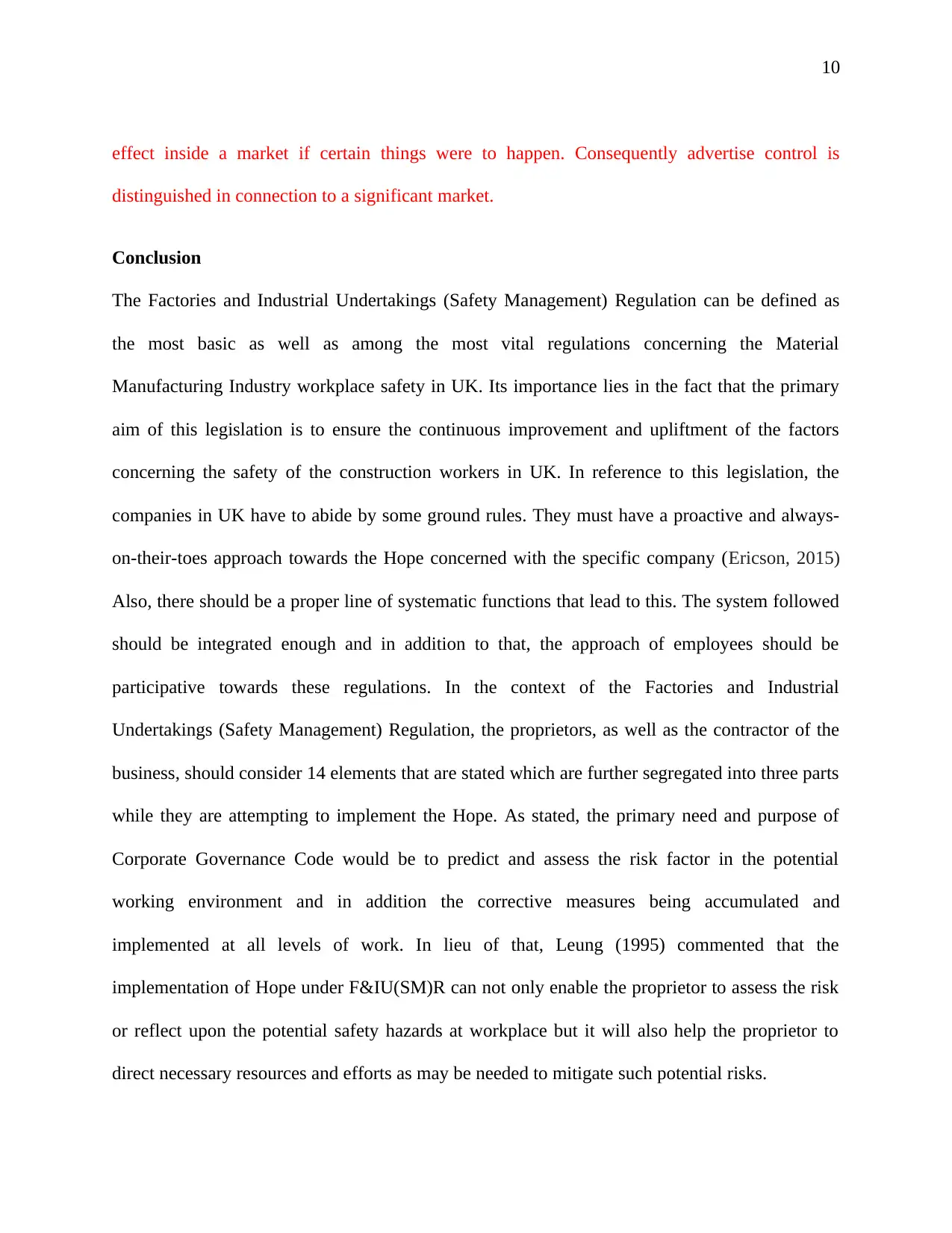
10
effect inside a market if certain things were to happen. Consequently advertise control is
distinguished in connection to a significant market.
Conclusion
The Factories and Industrial Undertakings (Safety Management) Regulation can be defined as
the most basic as well as among the most vital regulations concerning the Material
Manufacturing Industry workplace safety in UK. Its importance lies in the fact that the primary
aim of this legislation is to ensure the continuous improvement and upliftment of the factors
concerning the safety of the construction workers in UK. In reference to this legislation, the
companies in UK have to abide by some ground rules. They must have a proactive and always-
on-their-toes approach towards the Hope concerned with the specific company (Ericson, 2015)
Also, there should be a proper line of systematic functions that lead to this. The system followed
should be integrated enough and in addition to that, the approach of employees should be
participative towards these regulations. In the context of the Factories and Industrial
Undertakings (Safety Management) Regulation, the proprietors, as well as the contractor of the
business, should consider 14 elements that are stated which are further segregated into three parts
while they are attempting to implement the Hope. As stated, the primary need and purpose of
Corporate Governance Code would be to predict and assess the risk factor in the potential
working environment and in addition the corrective measures being accumulated and
implemented at all levels of work. In lieu of that, Leung (1995) commented that the
implementation of Hope under F&IU(SM)R can not only enable the proprietor to assess the risk
or reflect upon the potential safety hazards at workplace but it will also help the proprietor to
direct necessary resources and efforts as may be needed to mitigate such potential risks.
effect inside a market if certain things were to happen. Consequently advertise control is
distinguished in connection to a significant market.
Conclusion
The Factories and Industrial Undertakings (Safety Management) Regulation can be defined as
the most basic as well as among the most vital regulations concerning the Material
Manufacturing Industry workplace safety in UK. Its importance lies in the fact that the primary
aim of this legislation is to ensure the continuous improvement and upliftment of the factors
concerning the safety of the construction workers in UK. In reference to this legislation, the
companies in UK have to abide by some ground rules. They must have a proactive and always-
on-their-toes approach towards the Hope concerned with the specific company (Ericson, 2015)
Also, there should be a proper line of systematic functions that lead to this. The system followed
should be integrated enough and in addition to that, the approach of employees should be
participative towards these regulations. In the context of the Factories and Industrial
Undertakings (Safety Management) Regulation, the proprietors, as well as the contractor of the
business, should consider 14 elements that are stated which are further segregated into three parts
while they are attempting to implement the Hope. As stated, the primary need and purpose of
Corporate Governance Code would be to predict and assess the risk factor in the potential
working environment and in addition the corrective measures being accumulated and
implemented at all levels of work. In lieu of that, Leung (1995) commented that the
implementation of Hope under F&IU(SM)R can not only enable the proprietor to assess the risk
or reflect upon the potential safety hazards at workplace but it will also help the proprietor to
direct necessary resources and efforts as may be needed to mitigate such potential risks.
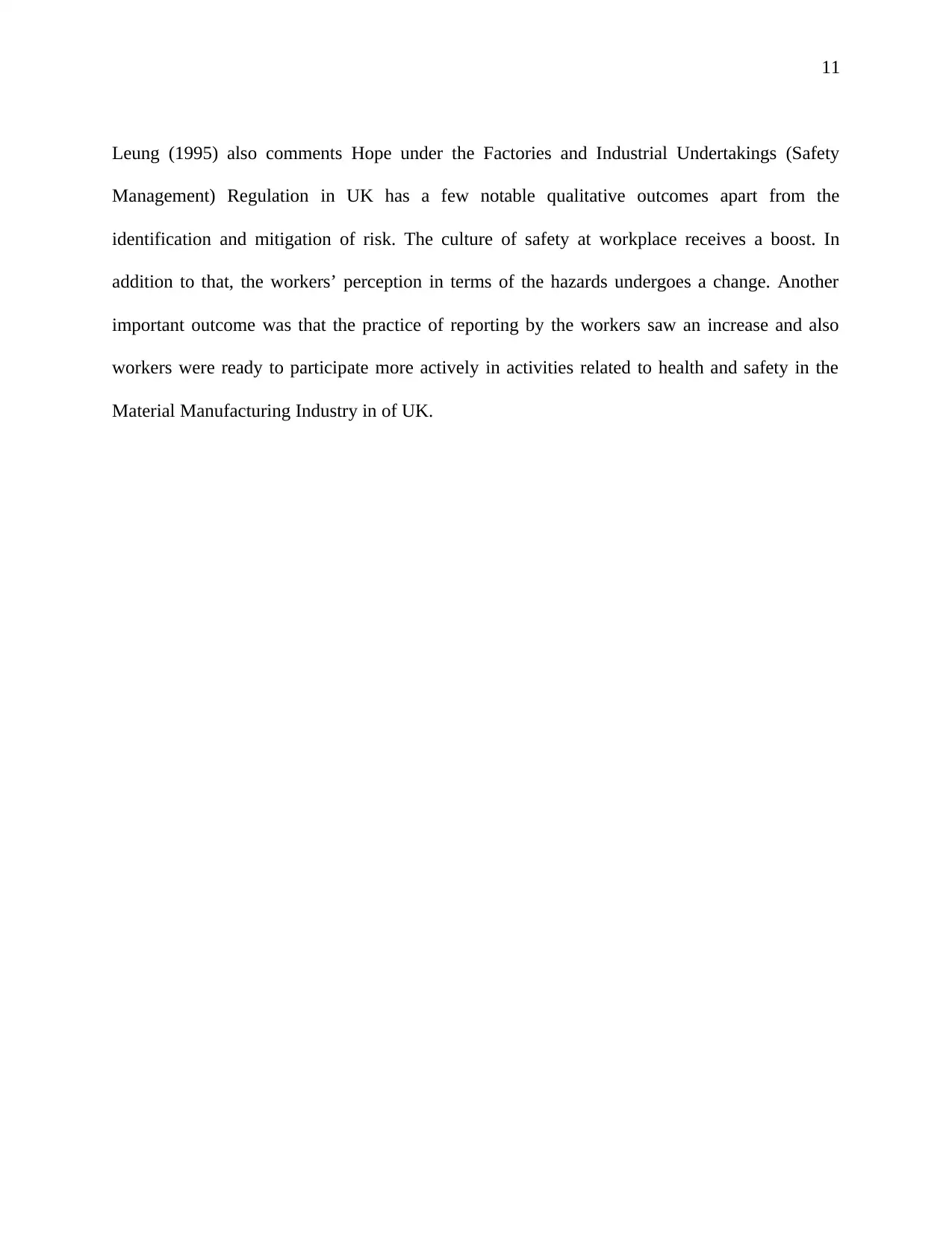
11
Leung (1995) also comments Hope under the Factories and Industrial Undertakings (Safety
Management) Regulation in UK has a few notable qualitative outcomes apart from the
identification and mitigation of risk. The culture of safety at workplace receives a boost. In
addition to that, the workers’ perception in terms of the hazards undergoes a change. Another
important outcome was that the practice of reporting by the workers saw an increase and also
workers were ready to participate more actively in activities related to health and safety in the
Material Manufacturing Industry in of UK.
Leung (1995) also comments Hope under the Factories and Industrial Undertakings (Safety
Management) Regulation in UK has a few notable qualitative outcomes apart from the
identification and mitigation of risk. The culture of safety at workplace receives a boost. In
addition to that, the workers’ perception in terms of the hazards undergoes a change. Another
important outcome was that the practice of reporting by the workers saw an increase and also
workers were ready to participate more actively in activities related to health and safety in the
Material Manufacturing Industry in of UK.
⊘ This is a preview!⊘
Do you want full access?
Subscribe today to unlock all pages.

Trusted by 1+ million students worldwide
1 out of 15
Related Documents
Your All-in-One AI-Powered Toolkit for Academic Success.
+13062052269
info@desklib.com
Available 24*7 on WhatsApp / Email
![[object Object]](/_next/static/media/star-bottom.7253800d.svg)
Unlock your academic potential
Copyright © 2020–2025 A2Z Services. All Rights Reserved. Developed and managed by ZUCOL.



